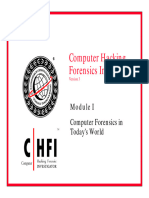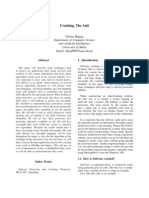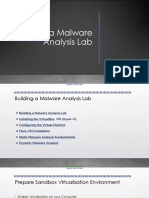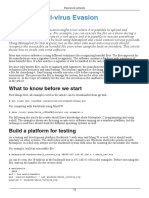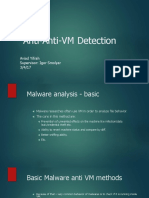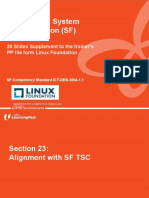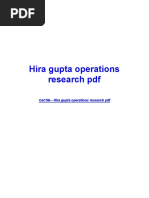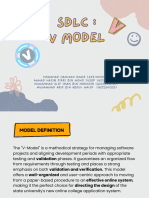0 ratings0% found this document useful (0 votes)
38 viewsStudy On Forensic Analysis of Physical Memory: Liming Cai, Jing Sha, Wei Qian
Study On Forensic Analysis of Physical Memory: Liming Cai, Jing Sha, Wei Qian
Uploaded by
kamelancienPhysical memory forensics is a technique of computer forensic used by forensic analysts, security specialists and those that analyze malware. Physical memory can be accessed to find more important information, such as the intruder's IP address, information about the running malicious program's processes, worms, trojans and so on. But once computer system is turned off, all these information will be lost. This paper describes the importance of the study on forensics analysis of physical memory.
Copyright:
© All Rights Reserved
Available Formats
Download as PDF, TXT or read online from Scribd
Study On Forensic Analysis of Physical Memory: Liming Cai, Jing Sha, Wei Qian
Study On Forensic Analysis of Physical Memory: Liming Cai, Jing Sha, Wei Qian
Uploaded by
kamelancien0 ratings0% found this document useful (0 votes)
38 views4 pagesPhysical memory forensics is a technique of computer forensic used by forensic analysts, security specialists and those that analyze malware. Physical memory can be accessed to find more important information, such as the intruder's IP address, information about the running malicious program's processes, worms, trojans and so on. But once computer system is turned off, all these information will be lost. This paper describes the importance of the study on forensics analysis of physical memory.
Original Title
56
Copyright
© © All Rights Reserved
Available Formats
PDF, TXT or read online from Scribd
Share this document
Did you find this document useful?
Is this content inappropriate?
Physical memory forensics is a technique of computer forensic used by forensic analysts, security specialists and those that analyze malware. Physical memory can be accessed to find more important information, such as the intruder's IP address, information about the running malicious program's processes, worms, trojans and so on. But once computer system is turned off, all these information will be lost. This paper describes the importance of the study on forensics analysis of physical memory.
Copyright:
© All Rights Reserved
Available Formats
Download as PDF, TXT or read online from Scribd
Download as pdf or txt
0 ratings0% found this document useful (0 votes)
38 views4 pagesStudy On Forensic Analysis of Physical Memory: Liming Cai, Jing Sha, Wei Qian
Study On Forensic Analysis of Physical Memory: Liming Cai, Jing Sha, Wei Qian
Uploaded by
kamelancienPhysical memory forensics is a technique of computer forensic used by forensic analysts, security specialists and those that analyze malware. Physical memory can be accessed to find more important information, such as the intruder's IP address, information about the running malicious program's processes, worms, trojans and so on. But once computer system is turned off, all these information will be lost. This paper describes the importance of the study on forensics analysis of physical memory.
Copyright:
© All Rights Reserved
Available Formats
Download as PDF, TXT or read online from Scribd
Download as pdf or txt
You are on page 1of 4
Study on Forensic Analysis of Physical Memory
Liming Cai, J ing Sha ,Wei Qian
Key Laboratory of Information Network Security, Ministry of Public Security,
Peoples Republic of China The 3rd Research Institute of Ministry of Public Security. Shanghai, China
{cailiming, shajing, qianwei}@stars.org.cn
AbstractIn this paper we firstly describe the importance of
the study on forensics analysis of physical memory. Further we
introduce some tools and techniques commonly used in
forensics analysis of physical memory. Lastly we present an
example of forensic analysis to illustrate how to do physical
memory forensics and analysis in a windows system by using
existing tools.
Keywords- computer forensics; physical memory forensic;
physical memory analysis
I. INTRODUCTION
As the development of computer technology, computer
crime has become an increasing problem. In such
circumstance, more and more attention has been paid on the
computer forensic. Analyzing systemmemory for artifacts is
a technique of computer forensic used by forensic analysts,
security specialists and those that analyze malware.
Since a considerable part of the computer crime evidence
can not be extraction from permanent storage medium such
as system's hard disk. We must access the computer system's
physical memory to find more important information, such
as the intruder's IP address, information about the running
malicious programs processes, worms, trojans and so on.
We also could extract some sensitive information frome-
mail and instant messaging tools through the analysis of the
dumped physical memory. But once computer system is
turned off, all these information will be lost. Therefore, the
research on forensics and analysis of physical memory has
practical significance on the promotion of the development
of computer forensics technology.
Foreign research on the computer's physical memory
forensic began in 2005. However, the study in this field in
our country is still very weak. And so far very few domestic
research papers about forensics analysis of physical memory
were published.
In this paper we will introduce the key technology of
physical memory forensics and some common software and
hardware tools used in physical memory forensics. Then we
will describes how to obtain a complete copy of system
memory froma live computer using program Dumplt, and
how to analyze this memory dump with the popular memory
analysis tool Volatility. Finally, we will present some
problems and further work about the current research of
physical memory forensics.
II. TOOLS AND TECHNIQUES ABOUT FORENSICS
ANALYSIS OF PHYSICAL MEMORY
A lot of information on computer such as the system
process, network information, login information, registry
information and so on must be accessed by obtaining and
analyzing the target computers physical memory dump. In
this section we will introduce some tools and techniques
commonly used in forensics analysis of physical memory to
find the important information.
The key technology of forensics analysis of physical
memory mainly includes two aspects: acquisition of physical
memory and analysis of collected physical memory. That is
to say, firstly how to obtain physical memory and generate
physical memory image file; secondly how to find out
important evidence through the analysis of physical memory
image file.
A. Acquisition of physical memory
There are two approaches to acquire physical memory
images: hardware based tools and software based tools.
1) Hardware based tools: The hardware based approach
is to bypass the operating systemby means of a physical
device. The dedicated hardware will open a dedicated
communication port to copy the contents of the physical
memory.
One is a dedicated PCI card named Tribble, which
requires installation before incident occurrence. The card can
easily be detached after the incident. In this way the state of
the system is preserved to search for digital evidence. The
advantage of this approach is the ease of use and the null
impact on the system. The biggest disadvantage of this
approach is that the hardware must be pre-installed. So the
device cant yet be widely used.
Another is FireWire bus, also known as IEEE 1394 bus.
Investigators can obtain the systems physical memory
mirroring by utilizing the special properties of FireWire
device. FireWire devices with the technology of direct
memory access (DMA) can directly access the system
memory without CPU. The advantage of this approach is the
FireWire port is a popular port present in many systems. And
the data transfer speed is very fast through FireWire port.
The disadvantage of this approach is the generation of
physical memory mirroring may cause system crash or lose
some information in memory.
2) Software based tools: There are several software
tools used in obtaining physical memory image. Here we
will introduce two commonly used software tools.
2nd International Symposium on Computer, Communication, Control and Automation (3CA 2013)
2013. The authors - Published by Atlantis Press 221
Data Dumper (DD) is the most commonly used software
tools in UNIX system. It can be used in copying files or
creating images. GMG System has released a free download
forensic acquisition tool bag so that it can run on Windows
system and generate the systems physical memory dump.
DumpIt is a compact portable tool which makes it easy to
save the contents of PC's physical memory. It's a console
utility, but there's no need to open a command line, or master
a host of cryptic command line switches. Instead, all you do
is double-click the program's executable, press "Y" to
confirmthat you're "sure you want to continue". And that's it,
DumpIt will save the contents of RAM to a file in DumpIt's
current folder. We will use this tool in the following example.
B. Analysis of physical memory
The next work is to analyze the obtained physical
memory dump. We should extract useful evidence in the
memory dump. Commonly, we could extract the following
information in the memory dump.
processes running in memory
loaded module and DLL, including implanted
malicious programs
systems registry information
The information listed above is most commonly
concerned by forensic investigators. Of course, we also could
analyze other data in the memory dump to get other
information. In next section we will present an example of
forensic analysis of physical memory to illustrate how to
acquire the information listed above by using existing tools.
III. EXAMPLE OF FORENSIC ANALYSIS
A. Obtaining a memory dump with DumpIt
Simply download DumpIt [6], put it onto a USB drive or
save it on your hard drive, double click it, select yes. And
then we obtain a complete copy of machines memory (See
Figure 1). The file extension of the image file generated by
DumpIt is *raw.
The only thing we need to notice is that it is large enough
to hold the file that is created if using a USB drive. The
memory dump will be a little larger than the size of your
installed RAM.
Figure 1. Creating a memory dump file with DumpIt
B. Analyzing a memory image with Volatility
Once we have the memory dump saved, we can now
analyze it with Volatility[7]. First, we should view the
summary information of the memory dump obtained by
using imaginfo command. Specifically, this command can
display the host operating systemversion, service packs and
hardware architecture (32-bit or 64-bit) and the time of the
generation of the memory dump and other basic
information(See Figure 2). For now, we just need to know
the profile type of the memory dump, in this case
Win7SP1x64. We will use this in the next few steps.
Figure 2. Execution of imaginfo command
1) Analyzing process list. Now lets take a look at
recovering a list of the running processes and active network
connections from the captured memory file. Using
Volatilitys pslist command can be used to view the
processes that were running on the Windows system
Figure 3. Execution of pslist command
Fromthe output of the command (See Figure 3), we see
the physical memory location, process name and the PID
number of all process that were running.
But pslist command is not able to detect hidden processes
in memory and process information disappeared in process
list as the system is attacked. Psscan command can solve this
problem. Psscan command can list all processes in system
through the technology of memory pool tag finding. This
command is not only able to display the current active
process information in memory, but also is able to display
222
terminated process and hidden process. And it is the hidden
process in memory forensics has important reference value.
Figure 4. Execution of psscan command
Figure 5. Output of psscan command
Part of the results after running psscan command showed
in Figure 5. We can discover what actions users have done
by analyzing the condition of three running process which
are underlined in Figure 5. User opened the chrome browser
at 2013-9-16 11:33:06. After 2 seconds the user opened the
chrome browser again at 2013-9-16 11:33:08. The user
closed the chrome browser at 2013-9-16 12:44:25. User ran
the process of MOM.exe at 2013-9-16 11:08:25. The process
has been running since the moment of obtaining the memory
mirroring. And the process ID is 3164.
2) Analyzing information of DLL. What is MOM.exe? Is
it a virus program? Now we may view DLL files loaded in
the specified process and then learn more about what the
procedure MOM.exe is.
We could view information of DLL in memory by dlllist
command. If we only need to look at loaded DLL files of a
specific process instead of all processes, we can use p PID
option to filter the output.
Figure 6. Execution of dlllist command
From the output of the command (See Figure 6), we can
see the path of the program MOM.exe and all the loaded
DLL files with its base address when the process is running.
Now we could determine the program MOM.exe is not a
virus program. It is normally just a part of a programcalled
the ATI Catalyst Control Center. We could know more about
the running process or do more another analysis by executing
dlllist command.
3) Analyzing registry keys. Registry plays a very
important role in configuration and control of a computers
operating system. It is primarily used to store the
configuration information of the operating system and users
application. Registry is not a simple large file, but a
collection. Registry file mainly include two categories, the
first category stores static data on the disk. Such registry
files are generally stored in the operating system
system32\config folder. Second category stores volatile
registry data. Such registry file is the data in RAM
maintained by the Windows kernel which will be created at
every system startup time .
Figure 7. Execution of hivelist command
The results after running hivelist command showed in
Figure 7. We could locate the virtual addresses and physical
addresses in memory corresponding to the registry files on
hard drive. If we need to do further analysis of a registry key,
we must execute this command previously in order to locate
the virtual addresses of the registry key.
In general, forensic investigators can retrieve data from
registry related to information about hardware and software
configuration, users preference, information about systems
initialization configuration, user login and password
information.
IV. CONCLUSION
Forensics analysis of physical memory is relatively a new
field of research. The study started late. Although some
progress has been obtained, there are still many problems.
Firstly, it is a lack of reliable and practical hardware
device to access physical memory. Hardware based method
to get the systems physical memory is an ideal solution as it
almost doesnt affect systems physical memory. We could
obtain a very complete physical memory without irruption by
using hardware method. But the present hardware device
such as Tribble, FireWire and so on still need further
improvement
Secondly, although there are a lot of software tools for
acquisition of systems physical memory, software tools will
inevitably damage or even override the contents of physical
memory. How to improve software tools to make minimize
impact on physical memory is our next issue to research.
223
Thirdly, it is a lack of relatively mature tools for analysis
of physical memory. More powerful analysis tools need to be
researched and developed.
ACKNOWLEDGMENT
This work was financially supported by the basic science
project of Ministry of public security, project number:
2012GABJ C035 and National Development and Reform
commission, project number: [2012]1424.
REFERENCES
[1] H. Carvey. Windows Forensics Analysis. Syngress,2007.
[2] N. Ruff. Windows memory forensics. Journal in Computer Virology,
November 2007.
[3] J oanna Rutkowska. Beyond The CPU: Defeating Hardware Based
RAM Acquisition Tools (Part I: AMD case. Black Hat J apan,
February 2007.
[4] J . D. Kornblum. Exploiting the rootkit paradox with windows
memory analysis. Technical report.
[5] G. Palmer. A road map for digital forensic research. Technical report,
Report from the Digital orensic Research Workshop (DFRWS),
November 2001.
[6] MoonSols DumpIt goes Main stream. http://www.moonsols.com
[7] The Volatility Framework. http://code.google.com/p/volatility/
[8] http://code.google.com/p/volatility/wiki/FAQ
[9] Stefan Vomel,Felix Freiling. A survey of main memory acquisition
and analysis techniques for the windows operating system.Digital
Investigation 8 (2011)3-22
[10] Nicole Lang Beebe, J an Guynes Clark. Digital forensic text string
searching. Digital forensic esearch workgroup,2007.
[11] Pter Szr. Memory scanning under windows NT.Virus Bulletin
Conference, September 1999.
[12] Lodovico Marziale Golden G. Richard III Vassil Roussev Andrew
Case, Andrew Cristina. Face: Automated digital evidence discovery
and correlation. In proceedibgs of the annual DFRWS conference, 5,
2008.
[13] Ali Reza Arasteh and Mourad Debbabi. Forensic memory analysis:
Fromstack and code toexecution history. In proceedings of the annual
DFRWS, 2007.
[14] Mariusz Burdach. Digital forensics of the physical memory. March
2005.
[15] Carrier. J oe Grand carrier. A hardware-based memory acquisition
procedure for digital investigations. 2004.
224
You might also like
- Inspecting Kerberos Ticket Requests v1Document26 pagesInspecting Kerberos Ticket Requests v16f6c55kpmjNo ratings yet
- CHFI v3 Module 01 Computer Forensics in Todays WorldDocument41 pagesCHFI v3 Module 01 Computer Forensics in Todays WorldIsrael GonzalezNo ratings yet
- CPENTbrochureDocument9 pagesCPENTbrochuremy lover IamNo ratings yet
- Lab10 - DirbusterDocument15 pagesLab10 - DirbusterSaw GyiNo ratings yet
- TR18 AD MSFT Defence at ScaleDocument31 pagesTR18 AD MSFT Defence at ScalekeepzthebeezNo ratings yet
- Philcris Frequently Asked Questions (As of 14 Sep 2011) : Item No. Version Used in The Training Questions Answer CategoryDocument3 pagesPhilcris Frequently Asked Questions (As of 14 Sep 2011) : Item No. Version Used in The Training Questions Answer CategoryDirk Reyes BalmesNo ratings yet
- Beginning Microsoft Word: Practice 1: Cut, Copy and PasteDocument4 pagesBeginning Microsoft Word: Practice 1: Cut, Copy and Pasteakib1969No ratings yet
- 1-CheckList For Informatica New Project SetupDocument14 pages1-CheckList For Informatica New Project Setupareddy_bNo ratings yet
- Learning Objectives of Memory Analysis: SEPTEMBER 27, 2020Document14 pagesLearning Objectives of Memory Analysis: SEPTEMBER 27, 2020simasiku.oliver99No ratings yet
- ForensicsDocument3 pagesForensicsJosiah MarcanoNo ratings yet
- Module 07 Windows ForensicsDocument19 pagesModule 07 Windows ForensicsShaik Abdul Muneer100% (1)
- DIFO2023 Lab2 MobileDocument13 pagesDIFO2023 Lab2 Mobilelinnammouri01No ratings yet
- CHFI v10 Course ContentDocument8 pagesCHFI v10 Course ContentAbhijith UpNo ratings yet
- Building An Industrial Cybersecurity WorkforceDocument12 pagesBuilding An Industrial Cybersecurity WorkforceGodson JosephNo ratings yet
- GSM Course GSM CourseDocument62 pagesGSM Course GSM Coursegoon61927No ratings yet
- Forensic Analysis of Ransomware Infected Windows Hard Disk A Case StudyDocument4 pagesForensic Analysis of Ransomware Infected Windows Hard Disk A Case StudyInternational Journal of Innovative Science and Research TechnologyNo ratings yet
- CISCO Secure Intrusion Detection SystemDocument45 pagesCISCO Secure Intrusion Detection SystemFahmi Shah100% (1)
- ITB1 Documentation Detection of Phishing Website Using MLDocument49 pagesITB1 Documentation Detection of Phishing Website Using MLNAVYA TadisettyNo ratings yet
- Malware Analysis Professional: Anti-Reversing Tricks: Part 3Document54 pagesMalware Analysis Professional: Anti-Reversing Tricks: Part 3Saw GyiNo ratings yet
- Tool ComparisonDocument8 pagesTool ComparisonAndresMenkerNo ratings yet
- 15 - CHFI (Mobile and IoT Forensics) - RDDocument46 pages15 - CHFI (Mobile and IoT Forensics) - RDSHANDY SK -X MIPA3No ratings yet
- Guide To High-Volume Data Sources For SIEMDocument23 pagesGuide To High-Volume Data Sources For SIEMGiorgos TsigourakosNo ratings yet
- ShodanDocument1 pageShodancarlos olivaNo ratings yet
- CHFI v3 Module 12 Data Acquisition and DuplicationDocument44 pagesCHFI v3 Module 12 Data Acquisition and DuplicationIsrael GonzalezNo ratings yet
- Cyber Security MumbaiDocument18 pagesCyber Security Mumbairony raiNo ratings yet
- CHFI v3 Module 04 First Responder ProceduresDocument75 pagesCHFI v3 Module 04 First Responder ProceduresIsrael GonzalezNo ratings yet
- Anti Debugging TricksDocument6 pagesAnti Debugging TricksJavier Gimenez AlavaNo ratings yet
- Helix Opensource User Manual PDFDocument202 pagesHelix Opensource User Manual PDFDave GordonNo ratings yet
- Information Security: AuthenticationDocument50 pagesInformation Security: AuthenticationBích NgọcNo ratings yet
- Detection of Phishing Attacks Nakul AryaDocument10 pagesDetection of Phishing Attacks Nakul AryaAk MishraNo ratings yet
- Malware Analysis ExamplesDocument45 pagesMalware Analysis ExamplesANKITANo ratings yet
- Exploring NTFSDocument47 pagesExploring NTFShectorcuchilla_sv561No ratings yet
- CCFE Detailed Forensics ReportDocument13 pagesCCFE Detailed Forensics ReportHazel Nott100% (1)
- Cyber Defense Forensic Analyst - Real World Hands-On ExamplesDocument17 pagesCyber Defense Forensic Analyst - Real World Hands-On ExamplesSandeep Kumar SeeramNo ratings yet
- Security AutomationDocument30 pagesSecurity AutomationPavan KantamsettiNo ratings yet
- BitLocker Drive Encryption FlowDocument36 pagesBitLocker Drive Encryption FlowKurt RoggenNo ratings yet
- Agentless Architecture: The Benefits ofDocument5 pagesAgentless Architecture: The Benefits ofAnkitNo ratings yet
- Os Unit 2Document277 pagesOs Unit 2Kaviya KrishNo ratings yet
- Quantum RansomwareDocument27 pagesQuantum RansomwareTimmy BondNo ratings yet
- CHFI v3 Module 07 Understanding File Systems and Hard DisksDocument86 pagesCHFI v3 Module 07 Understanding File Systems and Hard DisksIsrael GonzalezNo ratings yet
- 27.2.16 Lab - Investigating An Attack On A Windows HostDocument8 pages27.2.16 Lab - Investigating An Attack On A Windows Hostbui lamNo ratings yet
- Building A Malware Analysis LabDocument9 pagesBuilding A Malware Analysis LabErdem EnustNo ratings yet
- CH 6Document38 pagesCH 6Ain AnuarNo ratings yet
- Enhanced ATM Security System With Automatic Abnormal Event Detection and Alert System To Reduce Banking CostDocument5 pagesEnhanced ATM Security System With Automatic Abnormal Event Detection and Alert System To Reduce Banking CostIJRASETPublicationsNo ratings yet
- Malwarebytes Cloud Console Administrator GuideDocument58 pagesMalwarebytes Cloud Console Administrator GuideKata PopescoNo ratings yet
- Static AnalysisDocument39 pagesStatic Analysissarim imran100% (1)
- Av EvasionDocument6 pagesAv EvasionSabri AllaniNo ratings yet
- Metasploit Basics, Part 15 - Post - Exploitation Fun (Web Cam, Microphone, Passwords and More)Document13 pagesMetasploit Basics, Part 15 - Post - Exploitation Fun (Web Cam, Microphone, Passwords and More)stefan22222222No ratings yet
- EPO Web API Scripting Guide En-UsDocument40 pagesEPO Web API Scripting Guide En-UsdanipajbrNo ratings yet
- Penetration Testing Framework 0.59 PDFDocument40 pagesPenetration Testing Framework 0.59 PDFSamir MirzəoğluNo ratings yet
- Malware & NETWORK AnalysisDocument36 pagesMalware & NETWORK Analysisspamsj1121No ratings yet
- Lab - Exploring Endpoint Attacks: RequirementsDocument16 pagesLab - Exploring Endpoint Attacks: RequirementsMohcine OubadiNo ratings yet
- Penetration Report DC 2Document10 pagesPenetration Report DC 2paforaNo ratings yet
- Anti VMDocument26 pagesAnti VMAnonymous LegionsNo ratings yet
- Detection of Cyber Attack in Network Using Machine Learning TechniquesDocument73 pagesDetection of Cyber Attack in Network Using Machine Learning Techniquesmounikasomla12No ratings yet
- PRESENTASI ThehiveDocument10 pagesPRESENTASI Thehive陈辽发 22No ratings yet
- NICF - Linux System Administration (SF) : 20 Slides Supplement To The Trainer's PP File Form Linux FoundationDocument22 pagesNICF - Linux System Administration (SF) : 20 Slides Supplement To The Trainer's PP File Form Linux FoundationMA MaalejNo ratings yet
- Automated Analysis and Deobfuscation of Android Apps & MalwareDocument84 pagesAutomated Analysis and Deobfuscation of Android Apps & MalwarestrokenfilledNo ratings yet
- Computer MisuseDocument25 pagesComputer MisusesajjadNo ratings yet
- Malware DetectionDocument17 pagesMalware DetectionSanjana.SNo ratings yet
- Database Activity Monitoring A Complete Guide - 2020 EditionFrom EverandDatabase Activity Monitoring A Complete Guide - 2020 EditionNo ratings yet
- Booting Linux Off of Google Drive - Ersei 'N StuffDocument12 pagesBooting Linux Off of Google Drive - Ersei 'N StuffHoang DoanNo ratings yet
- Remotely Operated Vehicle For Underwater InspectionDocument5 pagesRemotely Operated Vehicle For Underwater InspectionVIVA-TECH IJRINo ratings yet
- React TutorialDocument19 pagesReact Tutorial2022 12095No ratings yet
- Sample Paper - Maths Olympiad For Class 5Document8 pagesSample Paper - Maths Olympiad For Class 5AmitNo ratings yet
- Oracle Enterprise ManagerDocument190 pagesOracle Enterprise Managersrinivas malladiNo ratings yet
- Cosmos DB 4-12Document9 pagesCosmos DB 4-12Jurguen ZambranoNo ratings yet
- Online Cake Shop System: User Registration: User Can Register On The System and GetDocument3 pagesOnline Cake Shop System: User Registration: User Can Register On The System and GetRami MunawirNo ratings yet
- System Requirements Autodesk Autocad 2022Document3 pagesSystem Requirements Autodesk Autocad 2022IT Dpt of National TheatreNo ratings yet
- Spring FrameworkDocument17 pagesSpring Frameworktwinkz007100% (1)
- WP T and L - SyllabusDocument2 pagesWP T and L - SyllabusSATHYABAMA MADHANKUMARNo ratings yet
- Blazor For ASP NET Web Forms DevelopersDocument100 pagesBlazor For ASP NET Web Forms DevelopersnguyendinhanhvlqtNo ratings yet
- Firecracker microVMDocument4 pagesFirecracker microVMbalzofayeNo ratings yet
- Hira Gupta Operations Research PDFDocument4 pagesHira Gupta Operations Research PDFNithin Cp0% (4)
- At91sam9263-Ek File Browser v1Document4 pagesAt91sam9263-Ek File Browser v1Rishi KumarNo ratings yet
- Azure IoT Developer AZ-220 DumpsDocument11 pagesAzure IoT Developer AZ-220 Dumpskevin jackyNo ratings yet
- Customer User Guide: - Verified Gross Mass (VGM) - How To Submit VGM Data To Hapag-LloydDocument21 pagesCustomer User Guide: - Verified Gross Mass (VGM) - How To Submit VGM Data To Hapag-LloydELMONo ratings yet
- Subham Saha: Work ExperienceDocument5 pagesSubham Saha: Work Experienceaparna tiwariNo ratings yet
- Oracle Student Guide 113065985 Schedule Dec12 May13Document8 pagesOracle Student Guide 113065985 Schedule Dec12 May13kganeshkumaranNo ratings yet
- Security Features in Intouch 8.X: Tech Note 295Document6 pagesSecurity Features in Intouch 8.X: Tech Note 295Passenger MedeamNo ratings yet
- Bikalpa Devops ResumeDocument5 pagesBikalpa Devops ResumeSatishKumarSinhaNo ratings yet
- CN Lab ManualDocument6 pagesCN Lab ManualP MuthulakshmiNo ratings yet
- HPSA Agent Total ReinstallationDocument8 pagesHPSA Agent Total ReinstallationIsmail Mohd Ki YipNo ratings yet
- 200+ MS Excel Shortcuts: Shortcut Purpose Shortcut Purpose Shortcut Purpose Shortcut PurposeDocument1 page200+ MS Excel Shortcuts: Shortcut Purpose Shortcut Purpose Shortcut Purpose Shortcut PurposeOPS SD10No ratings yet
- Appunti Nexpose Admin GuideDocument3 pagesAppunti Nexpose Admin GuideasdNo ratings yet
- Hive Data ManipulationDocument4 pagesHive Data Manipulationud100% (1)
- Method 2: Automatically Start A VNC Session Via A Systemd Service ScriptDocument2 pagesMethod 2: Automatically Start A VNC Session Via A Systemd Service ScriptjoNo ratings yet
- Assignment 3 (Group 2)Document18 pagesAssignment 3 (Group 2)wkc27559No ratings yet

